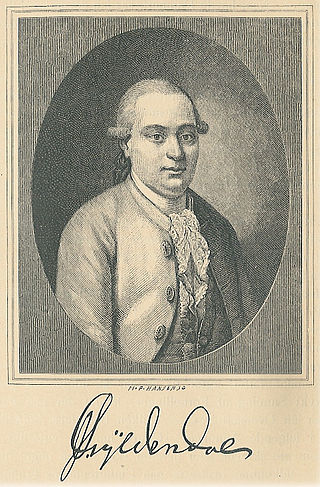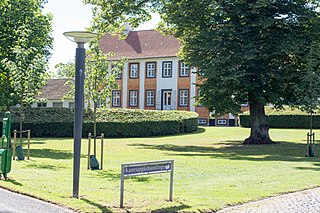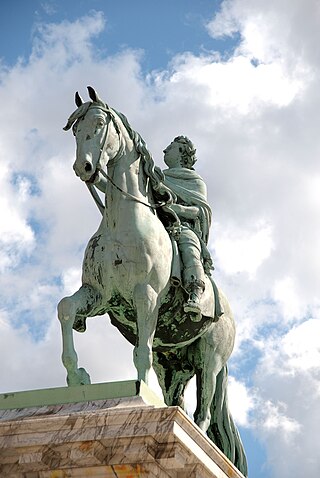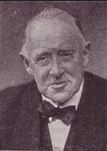Related Research Articles

Nicolai Abraham Abildgaard was a Danish neoclassical and royal history painter, sculptor, architect, and professor of painting, mythology, and anatomy at the New Royal Danish Academy of Art in Copenhagen, Denmark. Many of his works were in the royal Christiansborg Palace, Fredensborg Palace, and Levetzau Palace at Amalienborg.

Den Store Danske Encyklopædi is the most comprehensive contemporary Danish language encyclopedia. The 20 volumes of the encyclopedia were published successively between 1994 and 2001; a one-volume supplement was published in 2002 and two index volumes in 2003. The work comprises 115,000 articles, ranging in size from single-line cross references to the 130-page entry on Denmark. The articles were written by a staff of about 4,000 academic experts led by editor-in-chief Jørn Lund. Articles longer than a few dozen lines are signed by their authors. Many articles are illustrated.

Gyldendalske Boghandel, Nordisk Forlag A/S, usually referred to simply as Gyldendal, is a Danish publishing house.

Søren Gyldendal was a Danish bookstore owner who founded Gyldendal which became Denmark's largest publishing house.
Elias David Häusser was a German-Danish architect working in the Baroque and Rococo styles. He is most known for designing the first Christiansborg Palace which was almost completely destroyed in a fire in 1794. Häusser is credited with introducing both those styles to Denmark.

Kastrupgård is a former manor house in Kastrup, a suburb of Copenhagen, Denmark. Dating from the mid 18th century, it is now a museum housing the Kastrupgård Collection (Kastrupgårdsamlingen) of modern art, which is owned and operated by Tårnby Municipality.
Ole Falkentorp was a Danish architect.

Danish sculpture as a nationally recognized art form can be traced back to 1752 when Jacques Saly was commissioned to execute a statue of King Frederick V of Denmark on horseback. While Bertel Thorvaldsen was undoubtedly the country's most prominent contributor, many other players have produced fine work, especially in the areas of Neoclassicism, Realism, and in Historicism, the latter resulting from growing consciousness of a national identity. More recently, Danish sculpture has been inspired by European trends, especially those from Paris, including Surrealism and Modernism.

Engelsholm Castle, overlooking Engelsholm Lake, is located 14 km west of Vejle in south-western Denmark. Originally a manor house which traces its history back to the 15th century, it now houses a folk high school.

Skjoldenæsholm Castle is a manor house located 11 kilometres north-east of Ringsted, Denmark, standing on the west side of one of the many lakes which dominate the area. The Neoclassical main building, possibly by Philip de Lange, is now run as a hotel and conference centre while the grounds play host to both the Skjoldenæsholm Tram Museum and a golf course. The rest of the land is mostly forested.

Christian Vigilius Blache (1838–1920) was a Danish marine painter. After studying at the Academy under C.F. Sørensen, he travelled widely painting ships and seascapes throughout Denmark as well as in Scotland, Iceland and the Faroe Islands. He was an early visitor to Skagen in the north of Jutland where an artists' colony was to emerge a little later.

Ledreborg is a palatial mansion near Lejre, 12 km (7.5 mi) to the southwest of Roskilde on the Danish island of Zealand. Today's Baroque building was completed in 1746 by Minister of State Johan Ludvig Holstein (1694–1763) who commissioned J.C. Krieger to carry out the work.

Constantin Marselis, or Constantijn Marselis, was a nobleman of the wealthy Dutch Marselis family.
Events from the year 1639 in Denmark.

Vilhelm Rasmus Andreas Andersen was a Danish author, literary historian and intellectual, who primarily focused on the study of Danish literature. He was one of the first to use the term "Golden Age of Culture" to refer to the 1800s, and his focus on bringing Danish literature to the public earned him great popularity. Andersen was instrumental in the development of the School of Radio, as a means of disseminating public education to prevent loss of cultural identity and treasures.
Martin Bussert or Morten Bussert Was a sculptor and Royal Master Builder in Denmark in the early of 1500s. His last name is sometimes recorded as "Bossart" or "Bussart".
Christian Jensen Morup Was a Danish architect who primarily worked at Jutland during the 1700s.

Tranbjerg Church is a church in Aarhus, Denmark, situated in the suburb Tranbjerg 9 kilometers south-west of Aarhus city center on the old country road between Aarhus and Horsens. Tranbjerg Church is from the 1100s, erected as a typical Danish Romanesque village church. Later additions in the 15th century added a Gothic tower and porch. Tranbjerg Church is the only church in Tranbjerg pastorate and Parish with 7.414 members of the Church of Denmark living in Tranbjerg Parish on 1 January 2016. Tranbjerg Church is devoted to St. Ursula and the 11.000 virgin handmaidens.
Harald Magnus Lønborg-Jensen was a Danish architect known as a productive church and restoration-architect.

Peder Jensen Lodehat was the bishop of the Diocese of Aarhus and a significant political figure in Denmark during the reign of Queen Margrete I. Lodehat was originally from a minor noble family in Zealand but made a career in the Catholic Church as bishop of a total of 3 dioceses. He served on the Danish Riksråd and had a role in getting Margrethe I appointed queen. Lodehat also had a central role in the creation of the Kalmar Union and may have authored the founding documents. The surname Lodehat stems from a type of hat, Lodehat, featured on the family coat of arms but although the family has become known under this name they likely didn't use it in their own time.
References
- 1 2 "Nicolaus Hinrich Rieman" (in Danish). Gyldendal's Encyclopedia, Den Store Danske. Archived from the original on 6 February 2016. Retrieved 6 February 2016.
- 1 2 "Byggeskik" (in Danish). Gyldendal's Encyclopedia, Den Store Danske. Archived from the original on 4 March 2016. Retrieved 6 February 2016.
- ↑ Israelsen, N. J. (1967). Nicolaus Hinrich Rieman : bygmester i Jylland. Arkitekten.